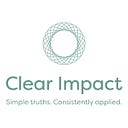The Wake I Leave
Reflecting on how we impact others within our care
We ran a large-scale leadership development program that attracted considerable international attention. With 40 hours of curriculum with us, over 9 months, the average gain in the ability to think effectively about complex problems was equivalent to over two full years of graduate school, using the most rigorous and accurate assessment available. This short article describe the first leadership mindfulness tool we introduced, and it was a major attention-getter.
This simple statement. The Wake I Leave, has made a huge impact on so many of the thousands of leaders with whom we’ve worked. Please read on.
We know from neuroscience that some of our systems are “closed loop.” What goes on in my body doesn’t impact that same system in yours. But our emotions run on an “open loop.” We’re emotionally contagious with each other. This likely developed to support empathy, compassion, and ultimately cooperation and community.
In organizational settings emotions generally run from the top down. That is, people tend to “pick up” the emotional energy of those to whom they report.
In our leadership programs, we tell our participants that they Leave a Wake in every interaction they have, and there are two vitally important questions:
- What kind of wake did you leave? After the interaction you had, whether meeting with one person or many, and whether the interaction was one minute or two hours, did you leave a positive or negative wake? A positive wake could include leaving people more engaged, connected, energized, enthusiastic. Feeling safer, more trust, more supported. A negative wake could include leaving people more agitated, anxious, scared, unsafe, and unsupported. Shut down, made wrong, blamed.
- And did you even notice? This is the question that is most jarring. Many if not most of our leaders acknowledged that they actually had no idea. It just wasn’t something they paid attention to. Not on their radar. They had the interaction without any part of their brain scanning for the impact on the other human being(s).
We define leadership capacity as the ability to lead more effectively in times of increasing VUCA (volatility, uncertainty, complexity, ambiguity) and rapid change. We tell participants that the only way to build capacity is through applied mindfulness, short cycles of action and reflection throughout the day. This takes very little time, but has a profound impact. Please see this short article for more details.
So our leaders start paying attention to their impact on other humans. They ask themselves whether they left:
An Aftermath
An After-taste
or An Afterglow
Why is Leaving a Positive Wake so important?
We’ve worked with leaders who hold the position that people within their organizations are in their care, with deep concern about the impact they have.
We’ve also worked with leaders who scoff at caring about the happiness or internal state of those within their organizations, even saying it’s none of their concern.
In fact we’ve worked with both kinds of leaders within the last week.
We apply the study of adult development to leadership effectiveness, and map the worldviews or mindsets of leaders at different stages. Please see this article for an in-depth description. Each stage is sequentially more effective for leading in complex environments. Later-stage or higher-capacity leaders increasingly recognize that people within their organizations are in their care, and that it’s essential to create cultures deeply imbued with trust and safety. They are curious about what energizes each person, and do their best to meet those needs, of course within the confines of getting the work done.
When people feel safe, engaged and empowered, they have more access to their brains’ executive functioning. This includes insight, agility, adaptability, response flexbility, perspective taking and seeking, ability to assess both short and long-term impact, and effective problem-solving. When people are outside their Window of Tolerance (anxious, angry, agitated, scared, numb, depressed, shut down) their decisions are more reactive and limited. Leaders aware of what we’re learning from neuroscience, even if they only cared about results, and didn’t really care about people for their own sake within an organizational context, would still see the business case for assisting people to be responsive rather than reactive.
And, of course, this isn’t true for most of the leaders with whom we work. They actually do care about their impact on other humans. They understand they are Co-Responsible for the performance of others. They just haven’t taken the time to build the mindfulness and capacity that allows them to focus on Task while also focusing on People. To learn more about Polarities, including Task & People, please read here.
Please try this simple practice. Before each interaction, take 30 seconds to have the intention to leave a positive wake, and think of one thing you might do to have this be more likely. At the end of the interaction, take another 30 seconds to ask yourself how it went. At the end of the day, take one or two minutes to reflect on the wake you left that day. This practice, alone, will have a profound impact.
Some people are happy wherever you go
Some people are happy whenever you go
Are people happier to see the front of you or the back of you?
Which one is you, most of the time?
And which one would you like to be true, most of the time?
Clear Impact Consulting Group is Dr. Joel M. Rothaizer, MCC, ABPP and Dr. Sandra L. Hill. Hopefully, this article has stimulated some new thinking. We welcome hearing from you. Our website is www.clear-impact.com and our email partner(at)clear-impact.com. We open-source all of our curriculum. Please see https://clear-impact.medium.com/ for all our Medium articles and our website for additional materials.
